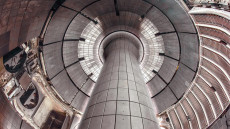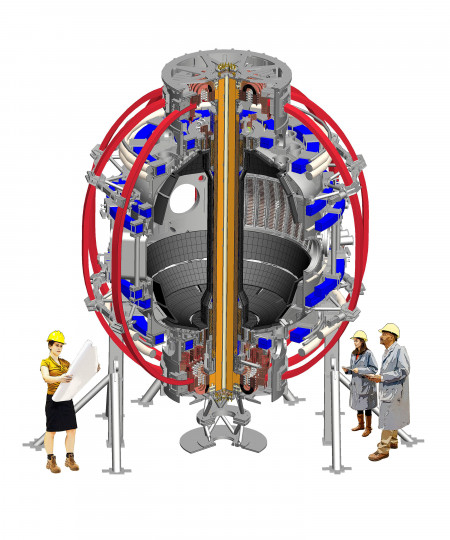Simulations at NERSC Drive Progress Toward Nuclear Fusion
May 31, 2022
By Elizabeth Ball
Contact: cscomms@lbl.gov

The NSTX-U is a nearly spherical, toroidal tokamak, meaning its outer shell is nearly perfectly round, and the inside is shaped like a donut.
Someday, scientists hope to harness nuclear fusion, the process that produces light and heat in our Sun and other stars, to produce clean, safe, renewable energy on Earth. Using simulations performed at the National Energy Research Scientific Computing Center (NERSC) at Lawrence Berkeley National Laboratory (Berkeley Lab), researchers at the U.S. Department of Energy’s Princeton Plasma Physics Laboratory (PPPL) have made new progress toward that goal.
By showing that design features of a PPPL reactor solve complex heat-exhaust problems related to nuclear fusion, they’ve reduced the barriers to the use of nuclear fusion as a widespread energy source. The results of this research were published in the journal Nuclear Fusion in March.
The National Spherical Torus Experiment-Upgrade (NSTX-U) at PPPL is a nearly spherical tokamak — a toroidal, or donut-shaped, nuclear fusion reactor that uses magnetic fields to contain the fusion reaction. First constructed in 1995 as NSTX, NSTX-U is currently being rebuilt and upgraded, and a series of simulations performed at NERSC show that its unique shape may help it disperse exhaust heat over a wider area on the material wall — making it a promising candidate for a pilot plant by the year 2040 in combination with other design features.

NSTX-U both nearly spherical and donut-shaped.
Nuclear fusion produces energy by combining atomic nuclei of two light elements (hydrogen isotopes) into a single nucleus of a heavier element (helium), releasing massive amounts of energy in the process. For fusion to take place, the elements must be in the form of a plasma, a superheated, charged state of matter made of positive ions and free electrons. On Earth, plasma must reach a temperature of around 150 million degrees Celsius to ignite a fusion reaction efficiently.
The exhaust heat released during fusion is a major obstacle for designing fusion reactors — even the strongest materials known to humankind cannot directly withstand such high temperatures. For the plasma to be as hot as an efficient fusion reaction requires without damaging the reactor, the exhaust heat must be dispersed before it reaches the reactor’s walls. Simulations show that turbulence at the edge of the plasma is an effective way of doing that, a phenomenon known as turbulent heat load spreading.
NSTX-U displays especially robust turbulent heat load spreading due to its tight aspect ratio — essentially, the hole in the donut at NSTX-U is smaller than that of a typical tokamak, compared with the width of the donut itself. The narrow space in the middle of the donut forces the confining magnetic field to be very strong as it passes through the center of the donut, and as electrons approach the hole of the reactor, the strong magnetic force field bounces some of them back into the donut, where the forces are weaker. This bouncing around of electrons causes a type of turbulence known as trapped-electron mode turbulence, which these simulations show is a particularly effective mechanism for heat load spreading.
“We found that trapped-electron mode turbulence is responsible for spreading the heat load,” said CS Chang, a PPPL plasma-boundary scientist and an author on the collaborative paper led by Walter Guttenfelder. “And we found that the best machine to test the physics of it is NSTX-U because it has a very tight aspect ratio — the center hole of the donut is very small. In that kind of machine, trapped-electron modes are supposed to happen much more strongly. We did the simulation, and in the paper, we have shown that, indeed, the heat load width is becoming wider and we see trapped-electron mode turbulence there.”
The simulations identifying these features at NSTX-U were performed on the Cori supercomputer at NERSC using XGC1, a particle-in-cell, five-dimensional gyrokinetic code. High-speed data transfer using ESnet, DOE’s high-speed network managed by Berkeley Lab, allowed researchers to observe the simulations in real time and tweak them as necessary in the next simulation. Work continues using the next-generation supercomputer Perlmutter at NERSC, which will make the work even more efficient: switching from Cori’s CPUs to Perlmutter’s GPUs “is an order of magnitude faster,” said Chang.
Understanding and validating trapped electron mode turbulence as a mechanism for dispersing exhaust heat during nuclear fusion is a big step toward designing fusion reactors for widespread use — and the next steps for this research include looking more closely at how the turbulence forms and how it works. “We would like to use NERSC to understand how plasma exhaust heat is traveling to the material wall called ‘diverter plates’ and how it’s diffused from turbulence,” said Chang. “When we verify the physics, then we can think about how we can enhance this effect by, say, inducing stronger turbulence.”
The more Chang and other scientists can learn about plasma edge turbulence and its uses, the simpler the future of fusion reactor design might be. Currently, nuclear fusion scientists sometimes try to control the temperature of the plasma traveling to the diverter plates and protect the reactor wall through injection of various atoms and other methods that introduce complications to the operation. A simple and effective method of dispersing heat would eliminate the need for those complications and allow for hotter and more efficient plasma reactions, and allow researchers to move on to other aspects of the fusion problem.
“If this simulation result is correct, then the heat load issue will be much easier to control in ITER,” said Chang, referring to the massive, internationally collaborative tokamak currently being constructed in southern France, which is scheduled to begin experiments in 2025–2026. “Without widening the heat load somehow, the operators of ITER have to extinguish the plasma fire right in front of the material plate. If they can find a way to spread the heat load wider, they can concentrate on other important progress.”
As those next steps continue, Chang and his team will be at the forefront and working for the future. “I wish to invent a way to spread the heat load even further by using turbulence,” he said. “If we can do that, the future of fusion reactor design will be much easier.”
NERSC and ESnet are DOE Office of Science user facilities.
About Computing Sciences at Berkeley Lab
High performance computing plays a critical role in scientific discovery. Researchers increasingly rely on advances in computer science, mathematics, computational science, data science, and large-scale computing and networking to increase our understanding of ourselves, our planet, and our universe. Berkeley Lab’s Computing Sciences Area researches, develops, and deploys new foundations, tools, and technologies to meet these needs and to advance research across a broad range of scientific disciplines.







 Instagram
Instagram YouTube
YouTube